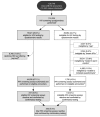Evolution and Escalation of an Emergency Department Routine, Opt-out HIV Screening and Linkage-to-Care Program
- PMID: 26862235
- PMCID: PMC4720611
- DOI: 10.1177/00333549161310S112
Evolution and Escalation of an Emergency Department Routine, Opt-out HIV Screening and Linkage-to-Care Program
Abstract
Objective: The Centers for Disease Control and Prevention has recommended emergency department (ED) opt-out HIV screening since 2006. Routine screening can prove challenging due to the ED's complexity and competing priorities. This study examined the implementation and evolution of a routine, integrated, opt-out HIV screening program at an urban academic ED in Alabama since August 2011.
Methods: ED routine, opt-out HIV screening was implemented as a standard of care in September 2011. To describe the outcomes and escalation of the screening program, data analyses were performed from three separate data queries: (1) encounter-level HIV screening questionnaire and test results from September 21, 2011, through December 31, 2013; (2) test-level, fourth-generation HIV results from July 9 through December 31, 2013; and (3) daily HIV testing rates and trends from September 9, 2011, through June 30, 2014.
Results: Of the 46,385 HIV screening tests performed, 252 (0.5%) were confirmed to be positive. Acute HIV infection accounted for 11.8% of all HIV patients identified using the fourth-generation HIV screening assay. Seventy-six percent of confirmed HIV-positive patients had successful linkage to care. Implementation of fourth-generation HIV instrument-based testing resulted in a 15.0% decline in weekly HIV testing rates. Displacement of nursing provider HIV test offers from triage to the bedside resulted in a 31.6% decline in weekly HIV testing rates.
Conclusion: This program demonstrated the capacity for high-volume, routine, opt-out HIV screening. Evolving ED challenges require program monitoring and adaptation to sustain scalable HIV screening in EDs.
Figures





References
-
- Branson BM, Handsfield HH, Lampe MA, Janssen RS, Taylor AW, Lyss SB, et al. Revised recommendations for HIV testing of adults, adolescents, and pregnant women in health-care settings. MMWR Recomm Rep. 2006;55(RR-14):1–17. - PubMed
-
- Waxman MJ, Popick RS, Merchant RC, Rothman RE, Shahan JB, Almond G. Ethical, financial, and legal considerations to implementing emergency department HIV screening: a report from the 2007 conference of the National Emergency Department HIV Testing Consortium. Ann Emerg Med. 2011;58(Suppl 1):33–43. - PubMed
-
- Mumma BE, Suffoletto BP. Less encouraging lessons from the front lines: barriers to implementation of an emergency department-based HIV screening program. Ann Emerg Med. 2011;58(Suppl 1):44–8. - PubMed
-
- Haukoos JS, Hopkins E, Hull A, Dean C, Donahoe K, Ruzas CM, et al. HIV testing in emergency departments in the United States: a national survey. Ann Emerg Med. 2011;58(Suppl 1):10–6. - PubMed
-
- Haukoos JS. The impact of nontargeted HIV screening in emergency departments and the ongoing need for targeted strategies. Arch Intern Med. 2012;172:20–2. - PubMed
Publication types
MeSH terms
Grants and funding
LinkOut - more resources
Full Text Sources
Other Literature Sources

